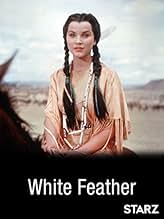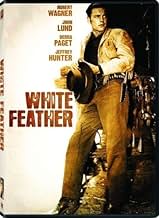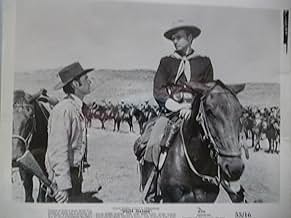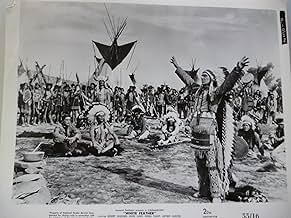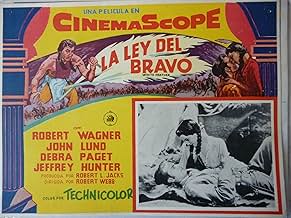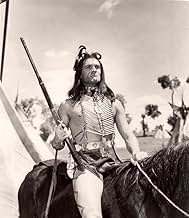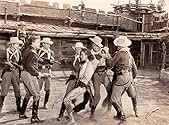Dans le Wyoming de 1877, pendant les négociations de paix entre les Cheyennes et les États-Unis, une Indienne tombe amoureuse d'un géomètre, ce qui provoque la colère de son fiancé Cheyenne.Dans le Wyoming de 1877, pendant les négociations de paix entre les Cheyennes et les États-Unis, une Indienne tombe amoureuse d'un géomètre, ce qui provoque la colère de son fiancé Cheyenne.Dans le Wyoming de 1877, pendant les négociations de paix entre les Cheyennes et les États-Unis, une Indienne tombe amoureuse d'un géomètre, ce qui provoque la colère de son fiancé Cheyenne.
- Réalisation
- Scénario
- Casting principal
- Lt. Ferguson
- (as Noah Beery)
- Indian Chief
- (non crédité)
This film seems to be the victim of poor editing. The Ann character played by Virginia Leith is potentially one of the most interesting in the film. There is more than a hint at the beginning that she has a dark secret. "Did my father tell you about me", she asks Josh Tanner (Wagner). Her father (played by Emile Meyer) later elaborates that "she is unfit merchandise". Unfortunately, this aspect of the plot is not developed. Jeffrey Hunter steals the show with his sympathetic and sensitive portrayal of Little Dog, a Cheyenne leader. He and Tanner become friends, and their friendship is one of the memorable elements in this film. Little Dog is proud to be a Cheyenne. He is torn between loyalty to his father, Chief Broken Hand (played by Eduard Franz), and his warrior code. In the end it becomes a choice between giving up his heritage to walk the White Man's road and dying well. The choice isn't as obvious as it seems. Little Dog's friend American Horse (played by Hugh O'Brian) has the opportunity to make the same choice and blows it.
This film's portrayal of the Native American tragedy is both sympathetic and different. Tanner tells the Colonel (played by John Lund) at the beginning that he has no feeling about Indians. He is indifferent. Ann makes her sympathies clear at the start. "I feel sorry for them," she says and she and Tanner watch the tribes as they prepare to sign a treaty giving up their lands. Ultimately, Tanner's friendship with Little Dog gives him a new perspective. Unlike "Devil's Doorway", another film which works hard to present the Native American view of the winning of the West, this film's ending is more upbeat. I still haven't been able to force myself to watch all of "Devil's Doorway".
Although marriages between Whites and Indians were not unusual in the real West, they had a difficult time surviving in the morality of films of the 40's and 50's. This film is one of the first in which a White character marries an Indian girl. Most Westerns of the time did not permit such relationships to become permanent. Paget's character in "Broken Arrow" is tragically killed. Similar violent endings terminate relationships in "Drum Beat", "Rock Island Line" and "Across the Wide Missouri". In "The Far Horizons" the Native American character ends the relationship by returning to her people so that one of the lead characters can marry a White woman. Dewey Martin's character in "The Big Sky" marries an Indian woman, but he has to make a choice. Will he return to the settlements where there is no place for her or will he live with the Blackfeet? Ultimately, he chooses Indian life. If the film's script had included part two of Guthrie's novel, we would see that this relationship was ultimately the victim of tragedy as well. Tanner's decision in this film to marry the Indian woman and live in the White world is truly unusual for films of the time.
It is the friendship between Tanner and Little Dog which makes the film worth watching. Wagner plays his relationship with Hunter's Little Dog with a lot more feeling and credibility than he does his romantic interest in Paget's character. Hunter's performance is a gem. Unlike Native American roles in so many other Westerns Hunter doesn't offer us the inane dialogue and dopey hand movements which we see too often in such roles. Although Tanner and Little Dog come from different worlds, their shared humanity is refreshingly realistic. It is ironic that their friendship becomes the catalyst for peace. Little Dog as a warrior is opposed to peace. "The treaty pen does not fit my hand", he jokes to Tanner.
Despite its flaws, this film is worth watching for its creative story and its sympathetic and credible portrayal of the Native American experience. The emphasis on story over action is unusual for such a Western and with a little better script it would have worked. Even so, it works well enough for me. I have watched it many times and will continue to do so.
Histoire
Le saviez-vous
- AnecdotesFirst American movie filmed (in 1954) in Durango, Mexico, because art director Jack Martin Smith liked the soundstages in the city and found the surrounding landscapes to be just what he was looking for.
- GaffesThe Army, at no time during the Indian Wars, used Winchester repeating lever action rifles, as shown.
- Citations
Josh Tanner: Eveything you will see in this movie actually happened, with the exception being the Indians' language. For the purposes of this story, they will speak English so that you can understand them.
- ConnexionsReferenced in Chappaqua (1966)
Meilleurs choix
- How long is White Feather?Alimenté par Alexa
Détails
- Date de sortie
- Pays d’origine
- Langue
- Aussi connu sous le nom de
- La plume blanche
- Lieux de tournage
- Fort Laramie National Historic Site - 965 Gray Rocks Road, Fort Laramie, Wyoming, États-Unis(actual Fort at center of events and activities portrayed)
- Société de production
- Voir plus de crédits d'entreprise sur IMDbPro
Box-office
- Budget
- 1 125 000 $US (estimé)
- Durée1 heure 42 minutes
- Rapport de forme
- 2.55 : 1
Contribuer à cette page














